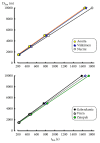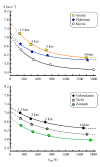Modelling of Running Performances: Comparisons of Power-Law, Hyperbolic, Logarithmic, and Exponential Models in Elite Endurance Runners
- PMID: 30402494
- PMCID: PMC6192093
- DOI: 10.1155/2018/8203062
Modelling of Running Performances: Comparisons of Power-Law, Hyperbolic, Logarithmic, and Exponential Models in Elite Endurance Runners
Abstract
Many empirical and descriptive models have been proposed since the beginning of the 20th century. In the present study, the power-law (Kennelly) and logarithmic (Péronnet-Thibault) models were compared with asymptotic models such as 2-parameter hyperbolic models (Hill and Scherrer), 3-parameter hyperbolic model (Morton), and exponential model (Hopkins). These empirical models were compared from the performance of 6 elite endurance runners (P. Nurmi, E. Zatopek, J. Väätäinen, L. Virén, S. Aouita, and H. Gebrselassie) who were world-record holders and/or Olympic winners and/or world or European champions. These elite runners were chosen because they participated several times in international competitions over a large range of distances (1500, 3000, 5000, and 10000 m) and three also participated in a marathon. The parameters of these models were compared and correlated. The less accurate models were the asymptotic 2-parameter hyperbolic models but the most accurate model was the asymptotic 3-parameter hyperbolic model proposed by Morton. The predictions of long-distance performances (maximal running speeds for 30 and 60 min and marathon) by extrapolation of the logarithmic and power-law models were more accurate than the predictions by extrapolation in all the asymptotic models. The overestimations of these long-distance performances by Morton's model were less important than the overestimations by the other asymptotic models.
Figures













Similar articles
-
Modeling of Running Performances in Humans: Comparison of Power Laws and Critical Speed.J Strength Cond Res. 2017 Jul;31(7):1859-1867. doi: 10.1519/JSC.0000000000001542. J Strength Cond Res. 2017. PMID: 27442329
-
Can we predict long-duration running power output? A matter of selecting the appropriate predicting trials and empirical model.Eur J Appl Physiol. 2023 Oct;123(10):2283-2294. doi: 10.1007/s00421-023-05243-y. Epub 2023 Jun 5. Eur J Appl Physiol. 2023. PMID: 37272943
-
The distance-time relationship over a century of running Olympic performances: A limit on the critical speed concept.J Sports Sci. 2006 Nov;24(11):1213-21. doi: 10.1080/02640410500497642. J Sports Sci. 2006. PMID: 17176525
-
The race within a race: Together on the marathon starting line but miles apart in the experience.Free Radic Biol Med. 2025 Feb 1;227:367-378. doi: 10.1016/j.freeradbiomed.2024.10.277. Epub 2024 Oct 10. Free Radic Biol Med. 2025. PMID: 39395564 Review.
-
Pacing profiles and tactical behaviors of elite runners.J Sport Health Sci. 2021 Sep;10(5):537-549. doi: 10.1016/j.jshs.2020.06.011. Epub 2020 Jun 26. J Sport Health Sci. 2021. PMID: 32599344 Free PMC article. Review.
Cited by
-
All models are wrong, but the critical power model is useful.Eur J Appl Physiol. 2024 Feb;124(2):669-670. doi: 10.1007/s00421-023-05359-1. Epub 2023 Nov 17. Eur J Appl Physiol. 2024. PMID: 37973650 No abstract available.
-
Connected model to optimize performance.Front Sports Act Living. 2023 Jan 13;4:1054783. doi: 10.3389/fspor.2022.1054783. eCollection 2022. Front Sports Act Living. 2023. PMID: 36713947 Free PMC article. No abstract available.
-
An empirical model for world record running speeds with distance, age, and sex: anaerobic and aerobic contributions to performance.J Appl Physiol (1985). 2024 Aug 1;137(2):357-363. doi: 10.1152/japplphysiol.00033.2024. Epub 2024 Jun 27. J Appl Physiol (1985). 2024. PMID: 38932687 Free PMC article.
-
Effects of Submaximal Performances on Critical Speed and Power: Uses of an Arbitrary-Unit Method with Different Protocols.Sports (Basel). 2019 May 31;7(6):136. doi: 10.3390/sports7060136. Sports (Basel). 2019. PMID: 31159341 Free PMC article.
-
Accuracy of smartwatches in predicting distance running performance.Front Sports Act Living. 2025 Jan 29;7:1517632. doi: 10.3389/fspor.2025.1517632. eCollection 2025. Front Sports Act Living. 2025. PMID: 39981510 Free PMC article.
References
-
- Hill A. V. Muscular Movement in Man: The Factors Governing Speed and Recovery from Fatigue. New York, NY, USA, London, UK: McGraw-Hill; 1927.
-
- Henry F. M. Time-velocity equations and oxygen requirements of “all-out” and “steady-pace” running. Research Quarterly for Exercise and Sport. 1954;25(2):164–177. doi: 10.1080/10671188.1954.10624956. - DOI
-
- Costill D. L. The relationship between selected physiological variables and distance running performance. The Journal of Sports Medicine and Physical Fitness. 1967;7(2):61–66. - PubMed
-
- Keller J. B. A theory of competitive running. Physics Today. 1973;26(9):43–47. doi: 10.1063/1.3128231. - DOI
Publication types
MeSH terms
LinkOut - more resources
Full Text Sources

